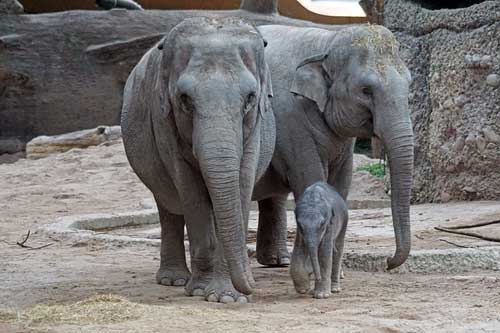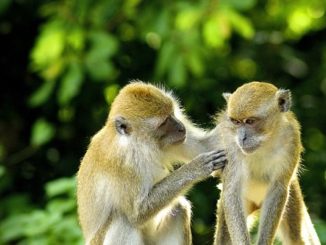Elephants are world largest non-ruminant herbivores present on earth. Due to their impact on their environments they are considered to be keystone species. Except predators such as lions, tigers, hyenas, and wild dogs, other animals tend to keep their distance from elephant. Elephants have a fission–fusion society, in which multiple family groups come together to socialize. Females (cows) tend to live in family groups, which can consist of one female with her calves or several related females with offspring. The groups, which do not include bulls, are led by the oldest cow, known as the matriarch. They do not chew cud, ruminate or belch as ruminant animals (like cattle, bison, goats, deer). Elephants may feed for up to 16 hours a day. Approx. 80% of an elephant’s day is spent on feeding. It consumes grasses, small plants, bushes, fruit, twigs, tree bark and roots. Tree bark is a favorite food source for elephants. Tusks are used to carve into the trunk and tear off strips of bark. An elephant usually digs up soil to full fill its salt and mineral requirements. Tusks are used to churn the ground. An elephant then places dislodged pieces of soil into its mouth, to obtain nutrients. Frequently these areas result in holes that are several feet deep and vital minerals are made accessible to other animals.
Species of elephants
Recognized species of elephants are the Asian elephant (Elephas maximus) of South and Southeast Asia, African bush elephant (Loxodonta africana) and forest elephant (Loxodonta cyclotis) of sub-Saharan Africa. African elephants have larger ears as compared to Asian elephants, a concave back, more wrinkled skin, a sloping abdomen, and two finger-like extensions at the tip of the trunk, whereas Asian have a convex or level back, smoother skin, a horizontal abdomen that occasionally sags in the middle and one extension at the tip of the trunk. The African molars are more diamond-shaped while those of Asian elephant have looped ridges. The Asian elephant also has dorsal bumps on its head and some patches of depigmentation on its skin.


Social Structure
The elephants social structure is complex, varying by gender, and population dynamics. Adult elephants form matriarchal (female-led) societies.
Adult male elephants are solitary in nature but may associate with other bulls (adult males) in small, unstable groups. Males will leave the family unit between 12 and 15 years of age.
Bulls that associate in small groupings have a hierarchal-ranking social structure. Age and strength factors will determine the leader, who protects the front and rear of the herd. More docile bulls serve as stabilizing members within the group they do not seek leadership roles, but whenever a male leaves or enters the group hierarchical roles are re-established and re-adjusted. Bulls do not have preferences for specific family units and will randomly move to different groupings daily and even hourly looking for reproductively receptive females. Although , bulls who are primarily solitary in nature will associate with non-natal family units (family units to which they are not related). The bulls wandering social system allows them to maximize reproductive potential with this a single bull can find up to 30 mates in a year, as opposed to fathering four calves in three years, if he associates with only one family unit
Female social structure is similar to concentric rings, with the innermost circle comprising a family unit of related adult cows (females). Family units range in size from three to 25 individuals; including the eldest, most dominant female called the matriarch, her adult daughters, and their calves, and a number of juveniles. From this stable core, the groupings widen to include less familiar individuals.
Matriarchs / Hierarchy Status
Matriarch is the oldest, most dominant female. The matriarch is the backbone of the elephant family unit because she provides stability and determines ranging patterns for the rest of the family. The other females comprising the family unit are usually the matriarch’s daughters and their offspring. Leadership, experience, and age determine the hierarchal ranking for these females. Generally, the older the female, the higher her ranking.
Protection and rearing of calves is the primary function of elephant family units. Adult females assists calf movements, foraging, protection, and social experiences which greatly increases survivability of calves.
These associated families are called kin or bond groups and will mingle, feed, and interact with one another frequently. Under ideal environmental circumstances, family units may congregate in groups of up to six families. Occasionally, there may be herd aggregations ranging in size from 500 to 1,000 individuals around watering holes and other consolidated resources. Large congregations of elephants occur more frequently with African elephants than Asian. In regions with less food, smaller elephant family units are found. In regions with abundant food, larger social groups are formed.
Social Behavior
Home Range
Elephants are not territorial. The home range is between 10 and 70 km2 (four to 27 mi.2) and possibly larger, depending on herd size and seasonality.
Dominance
A bull’s size, power, and weight will determine the level of dominance. Bulls that are in musth are particularly dominant than non-musth bulls.
Mourning Behavior
The nature of elephant social structure is extended into the mourning behavior for deceased companions. When elephants come across deceased remains of other elephants, a silent pause is taken, as the remains are touched with their trunks.
Individual Behavior
Musth
The musth period lasts between several days to several months. There is no seasonal pattern with musth. Bulls come into it different times. Elephants have a musth gland located just beneath the skin’s surface, halfway between the eye and ear, on each side of their head, musth glands secrete a dark, oily, musky substance and become inflamed. This physiological change is associated with a behavior observed in male elephants called musth, and is characterized by unpredictable, dominant, and excitable behavior.

Bathing or Dusting
Bathing is essential for elephants, to protect the skin from parasites and insects. The trunks are used like a hose to spray water across the body.

Sleeping
Elephants sleep about approximately four hours a night. About two hours of that are spent standing. During deep sleep, individuals lie on their sides, breathing noisily, and sometimes snoring.
Why elephants need to eat so much?
As comparison to other herbivores, the digestive strategy of elephants is characterized by fast ingesta passage, hence a comparatively low digestive efficiency. Digestive efficiency is so low that intact diet items often appear in the feces sometimes re-ingested by the elephants. Elephants can digest only 40% of what they eat, as consequences nutrients are not properly absorbed. This inefficient digestive system makes the elephants to eat large quantities of food to retain and absorb necessary nutrients for good health. Usually an elephant can eat between 200-250 kg per day. They require large amount of food even though their relative requirement per unit body size is comparatively lower than other herbivores.
Elephant digestive system
Most obvious and unique physical features of the elephant is its elongated upper lip and nose forming a muscular trunk capable of reaching from ground level to high branches in its search for food. Unlike the horse, the elephant has no canines or lower incisors and the upper incisors, when present have been modified to form tusks. The grinding teeth do not succeed each other vertically, as in most mammals.
A separate distensible pharyngeal pouch having a sphincter that regulates flow of food and fluid into the esophagus. The lateral movement of the jaws are not pronounced during mastication in elephants. Less volume of the buccal cavity inefficient mastication leads to poor digestibility and hence there is habit of continuous feeding in elephants. Stomach is cylindrical and large intestine has sacculated caecum & colon. Microbial fermentation takes place in caecum and colon.
Feeding
- The elephant feeds on leaves, bark, stem, twigs, pith, root, fruits and flowers. Elephants graze and browse on the more tender and palatable portions of different plants and trees. Elephants eat between 149 and 169 kg (330-375 lb.) of vegetation daily.
- Elephants are pure vegetarian and eat mainly fruits and leaves, such as bamboos, pineapple leave, cucumber, papaya, watermelon, sugarcanes, bananas, coconut leaves and also rice, but we have to steam it before to give it to the elephants. Per day they eat up to 250 kg green leaves and drink about 200 liters of water
- In drier habitats Grasses and legumes are more important while palms, vines and a variety of fruits are commonly consumed in moist forests. The elephants require a minimum of 150-200 liters of water each day. Apart from metabolic requirements elephants need water for their natural functions like spraying as well as wallowing for body temperature regulation since the elephant hardly sweats. An average sized adult Asian elephant loses 40 litres of water through urine and 20 litres through the lungs and skin.








Be the first to comment